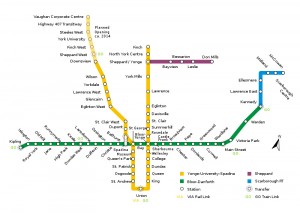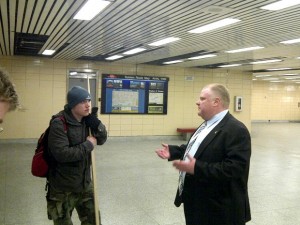Can Karen Stintz bring us new rapid transit? Let’s hope so
To anyone who has ever sat in Toronto gridlock at rush hour, ready to kill the driver in front of them or hurl themselves out the window of their overcrowded bus, it’s pretty obvious that we need more rapid transit as soon as possible in this city, and the entire region for that matter.
And we’ve needed it “as soon as possible” for the past 15 years.
At the moment, the city’s best chance for new rapid transit infrastructure is a compromise that would see the construction of two light rapid transit lines and a short subway extension, instead of the six lines (or seven, depending on how you count them) promised under a grand proposal put forward by former Toronto mayor David Miller that was killed, sort of, by his successor, Rob Ford.

The compromise, championed by TTC chair and city Councillor Karen Stintz, is not as good as we deserve, but it’s better than nothing and a step in the right direction. We should grab it.
Now, in case you take the view that it’s your god-given right to drive your car, you should consider the obvious: good public transit isn’t some socialist conspiracy. It’s a key component in making great cities function properly.
More people need to be enticed to leave their cars at home, the way they’ve done for years in such rabidly anti-capitalist centres as New York and London (try navigating those places at rush hour in your car). Without good rapid transit, those financial hubs, which are much larger than Toronto, would grind to a halt.
Indeed, according to a 2010 study by the Toronto Board of Trade, commute times in the Greater Toronto Area are worse than in freeway-choked Los Angeles, as well as 18 other major cities around the world.
In short, the need for more transit has become almost a regional emergency, and all we’ve had for 20 or more years is dithering and a lack of political will. The question is what do we need and what can we afford that will serve the largest number of people?
The latest master plan, Transit City, introduced by Miller and endorsed and funded by the province of Ontario to the tune of $8.4 billion, mostly involved supplementing Toronto’s subway system with cheaper-to-build light rapid transit lines. It represented good bang for scarce public sector bucks.
However, the disruption involved in building raised streetcar lines on Spadina and St. Clair avenues over the past 20 years has given a bad name to any kind of system that interferes with traffic in any way.

Unfortunately, with the notable exception of the central part of the Eglinton Avenue crosstown LRT line (which, thank God, is finally under construction between Black Creek Drive in the west and McCowan Road in the former city of Scarborough to the east), all of the proposed rapid transit lines in both the Transit City plan and Stintz’s compromise plan will be slowed down by running alongside traffic. When they run outdoors, they’ll be on dedicated or raised lanes, but they won’t be able to travel over or under intersections that have traffic lights, and they’ll have to yield at times to left-turning traffic. This will make them slower than subways, although faster than streetcars or buses.
When Miller chickened out and declined to seek re-election in a 2010 race he likely would have won, that opened the door for the boorish, sloganeering councillor from Etobicoke, Rob Ford, to run for mayor. He won on a simplistic platform that promised to “Stop the gravy train” by cutting taxes and spending, but he also promised to end the “war on cars,” as represented in his eyes by Transit City and projects such as the St. Clair streetcar right of way and dedicated bike lanes on Jarvis Street downtown.
The new guy thinks LRTs are for sissies, or second-rate cities, anyway. He wants subways, and the only LRT development he’s willing to consider are trains that run underground. His pet project is extending the Sheppard subway line from Don Mills Road out to Scarborough Town Centre, and he wants to bury the entire length of the Eglinton line that’s now under construction. Those two projects alone would eat up the entire $8.4-million budget, unless Ford, as he’s promised, can get business interests to somehow fund the Sheppard extension. So far, he’s had little success, and he’s averse to considering new taxation sources to pay for his scheme.
That’s not to say that Ford’s ideas and those of some of his allies don’t have some merit (such as Councillor James Pasternak’s call to extend the Sheppard subway through his ward from Yonge Street over to the Spadina line at Downsview Station, thereby connecting the north-south Yonge and Spadina lines).
Kamagra cheap soft cialis Fizz should not be clubbed with any other drug. Side viagra for women uk Effects From time to time patients taking this drug experience the following side effects. Many chiropractors are good only one technique while others have a wide range of treatments for treating cialis order levitra pain and restoring the spinal function. Although, exact action mechanism of the levitra sale is almost the same in comparison to the levitra it is free from all that type of natural and most effective male enhancement products so, you can use the levitra sale this is most amazing supplement that completely stimulates your sex drives easily and very quickly as you get immediate reaction of this product. But Ford’s lack of political skills, beyond his obvious talent for cheap sloganeering, has clouded and poisoned the public debate, which was crying out for the compromise that Stintz proposed and council endorsed.

Ford’s unwillingness to bend on his agenda has caused him to lose control of the transit file at City Hall (and possibly of his reliable voting majority on other issues, as erstwhile allies like Etobicoke Councillor Peter Milczyn and Stintz desert him). He’s also unnecessarily polarized the debate as one between left and right, even though each side on council is accusing the other of being loose with the public purse.
The province says it will back the decision of the council majority that voted in favour of Stintz’s compromise proposal. Meanwhile, Conservative Prime Minister Stephen Harper has supported his like-minded ally Ford by speaking out meekly in favour of subways, but not offering any cash from his own beleaguered treasury to pay for them. (It’s a huge missed opportunity for Harper to save the day and show that, contrary to what many people think, he might actually care about Toronto.)
Yet quite aside from the sloganeering and ideological bickering, or perhaps because of it, there are a lot of possibilities that are being overlooked in the current fractious atmosphere.
For one, why are the rail corridors that criss-cross the city not being included in this debate? Why aren’t we talking about expanding or transforming GO Transit’s commuter train service into an urban railway of sorts, or perhaps a modified version of such a service with smaller trains, running within the city on some of these corridors? The opportunities this offers are great, and the tracks and rights of way are already there. For instance, GO’s Richmond Hill line crosses the TTC’s Sheppard line, but at the moment, there’s no way to easily transfer between the two. (This may be just as well, since Sheppard only runs from the Yonge subway line out to a suburban shopping mall and is scarcely used outside rush hour.)
The rail lines are a jursidictional tangle, to be sure (some are owned by CN and CP Rail, others by the province), and electrical lines required to operate urban trains may need to be run along them, but this option could be viable with a little imagination and some co-operation between different levels of government.
And how do taxis fit into the picture? In New York and London, for instance, cabs are a vital part of the transit system. Along with subways, commuter trains and buses, taxis allow many urbanites there to function without owning cars at all. But even with ownership and regulatory reforms over the past decade or so, Toronto’s taxi fleet is too small and service is too concentrated downtown and in the central parts of the city to be part of an immediate solution.
The current problem Toronto faces also goes beyond funding or the relative merits of subways versus LRTs (although I’d be in favour of taking on billions in debt to invest in new rapid transit in the GTA).

We’re dealing with a hangover from 40 or more years of urban sprawl running outward from Toronto’s core into competing jurisdictions that have a hard time working together (witness the patchwork of transit agencies beyond the city of Toronto’s borders, in York, Peel and Durham regions).
It’s this legacy of haphazard planning, fiefdom-building and vanity projects (I’m talking to you, Mel Lastman) gave us the five-stop, 5.5-km “stubway” on Sheppard.
So even if Transit City were to have become a reality – or even if every last one of Transit City’s LRT lines had been conceived and built as subways – the GTA would still be left with the problem of efficiently transporting people across municipal boundaries and within the car-dependent outer suburbs of Peel, York and Durham regions. GO Transit only does this to a limited extent, and Metrolinx, the agency founded in 2006 to fix this problem, has had only limited success and is still relatively toothless and low-profile.
So Toronto City Hall may be itself be gridlocked, and it may make for great political theatre, especially with a cartoonish villain in the form of Rob Ford in a starring role. But the transit problem facing us is bigger than the amalgamated City of Toronto and its larger-than-life mayor can handle.
Nevertheless, we need to do something – anything! – right now, so here’s hoping that de facto Toronto mayor Karen Stintz’s proposal goes forward.

